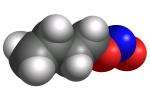
Summary
Butyl nitrite is the organic compound with the formula CH3(CH2)3ONO. It is an alkyl nitrite made from n-butanol. Butyl nitrite is used recreationally as poppers. Synonyms include 1-butyl nitrite, n-butyl nitrite and nitrous acid butyl ester.
 | |
 | |
| Clinical data | |
|---|---|
| ATC code |
|
| Legal status | |
| Legal status |
|
| Identifiers | |
| |
| CAS Number |
|
| PubChem CID |
|
| ChemSpider |
|
| UNII |
|
| CompTox Dashboard (EPA) |
|
| ECHA InfoCard | 100.008.057 |
| Chemical and physical data | |
| Formula | C4H9NO2 |
| Molar mass | 103.121 g·mol−1 |
| 3D model (JSmol) |
|
| Boiling point | 78.0 °C (172.4 °F) |
| |
| |
| (verify) | |
It can be prepared by treating nitrous acid (generated in situ) with n-butanol.[1]
Applications edit
Butyl nitrite is one of the compounds used as poppers, inhalant drugs that induce brief euphoria. It was developed by Clifford Hassing,[2][3] a graduate student in Los Angeles, as a faster-acting analog of alkyl nitrite. Among the inhalants' trade names are Rush, Locker Room, and Bolt. They are sometimes marketed as "Cleaner", liquid incense, or room odorizer. It is used for its euphoric effect and for relaxing the smooth muscles during sexual intercourse.[2][3]
See also edit
References edit
- ^ Noyes WA (1936). "N-Butyl Nitrite". Organic Syntheses. 16: 7. doi:10.15227/orgsyn.016.0007.
- ^ a b Orlean SC (5 February 1980). "Doctors Say It Can Kill You, but Butyl Nitrite Is a Legal High in Portland". Willamette Week. Retrieved 5 June 2022.
- ^ a b Mack D (27 July 2021). "This Man Does Not Make Poppers". BuzzFeed News. Retrieved 5 June 2022.


